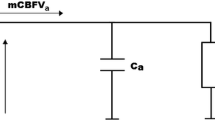Abstract
The 133Xe clearance technique is used to measure cerebral blood flow in the pig. Previous publications have shown that the two-compartmental model is inadequate for interpreting the experimental data. The present study deals with certain phenomena seen during the initial part of the clearance curves, which can lead to incorrect estimation of the blood flow rate.
Two types of initial peaks can be distinguished: one is a very fast type, which is interpreted as being due to transit of the tracer via large vessels and is referred to in the literature as the ‘arterial peak’; the second is a slower ‘tissue peak,’ seen in animal experiments at high CO2 levels and in clinical patients with cerebrovascular instability.
In animal preparations discrepancies were found between flow measurements according to the 133Xe clearance technique and those made with the aid of an electromagnetic flow probe situated around the carotid artery. A hysteresis effect was also found in the relation between respired CO2 level and cerebral blood flow.
All these findings can be interpreted in terms of arteriovenous shunting, i.e., non-nutrient flow of blood, which is not necessarily due to anatomical anastomosis but can also be explained by the assumption that the clearance is partly limited by diffusion.
The possibility of diffusion-limited clearance can have important clinical implications. Further research may provide a better basis for analysis of clearance curves to detect cerebral perfusion deficiencies that give rise to false flow calculations in present techniques.
Similar content being viewed by others
References
Allan L, Smith G, Neufeld R, Ominsky J, Wollman H (1970) Interrelations among cerebral blood flow mean transit time and vascular volume. Fed Proc 29-I:519, abstr. 1526
Duyl WA van (1977) Cerebral blood flow in the pig: A study of Xe-133 clearance techniques. Thesis, Rotterdam
Duyl WA van, Kruijk A de (1978) Instability of photomultiplier tubes and consequences for accuracy of radioactivity measurements. Med Prog Technol 6:29–34
Duyl WA van, Mechelse K, Sparreboom D, Volkers ACW (1975) Interpretation of differences between ‘81-keV’ and ‘31-keV’ decay curves recorded during clearance of Xe-133 in cerebral tissue of the pig. In: Langfitt Th W, McHenry LC, Reivich M, Wollman H (eds), Cerebral circulation and metabolism. Springer, Berlin, Heidelberg, New York, pp 409–412
Duyl WA van, Sparreboom D, Volkers ACW (1976) Compartmental models of cerebral blood flow. Analysis using the ‘81-keV’ and ‘31-keV’ photons of Xe-133. J Nucl Med 17:596–602
Duyl WA van, Volkers ACW (1978) Intra-arterial gas/compartmental analysis. Prog Nucl Med 5: 190–203. Karger, Basel
Duyl WA van, Volkers ACW (1980) Measurement of cerebral blood flow in the pig by the Xe-133 clearance technique: Failure of the two-compartmental clearance model. Eur J Nucl Med 5:89–96
Fan FC, Schuessler GB, Chen RYZ, Chien S (1979) Determinations of blood flow and shunting of 9 and 15 μm spheres in regional beds. Am J Physiol 237:25–33
Grubb RL, RaichleME, EichlingJO, Ter-Pogossian MM (1974) The effects of changes in PaCO2 on cerebral blood volume, blood flow and vascular mean transit time. Stroke 5:632–639
Harper AM, Glass HJ (1965) Effect of alterations in the arterial carbon dioxide tension on the blood flow through the cerebral cortex at normal and low arterial blood pressure. J Neurol Neurosurg Psychiat 28:449–452
Kirkegaard PA (1970) A Fortran IV version of the sum of exponential square code exposum. Report Risö-M-1279 Research Est. Risö, Danish Atomic Energy Commission, Sept. 1970
Lassen NA, Ingvar DH (1972) Radioisotope assessment of regional cerebral blood flow. Progr Nucl Med 1:376–409. Karger, Basel
Leech PJ, Miller JD, Fitch W, Barker J (1974) Cerebral blood flow, internal carotid artery pressure and the EEG as a guide to the safety of carotid ligation. J Neurol Neurosurg Psychiatr 37:854–862
Olesen J, Paulson OB, Lassen NA (1971) Regional cerebral blood flow in man determined by the initial slope of the clearance of intra-arterially injected Xe-133. Stroke 2:519–540
Paulson OB, Cronqvist S, Risberg J, Jeppesen FJ (1969) Regional cerebral blood flow: A comparison of 8-detector and 16-detector instrumentation. J Nucl Med 10:164–173
Rowbotham GF, Little E (1965) A new concept of the circulation and the circulations of the brain: The discovery of surface arteriovenous shunts. Br J Surg 52:539–542
Smith A, Neufeld GR, Ominsky AJ, Wollman H (1971) Effect of arterial CO2 tension on cerebral blood flow, mean transit time and vascular volume. J Appl Physiol 31:701–707
Author information
Authors and Affiliations
Rights and permissions
About this article
Cite this article
Volkers, A.C.W., van Duyl, W.A. Measurement of cerebral blood flow in the pig by the 133Xe clearance technique. Eur J Nucl Med 6, 461–468 (1981). https://doi.org/10.1007/BF00252804
Received:
Issue Date:
DOI: https://doi.org/10.1007/BF00252804




